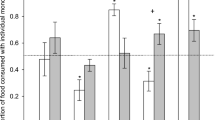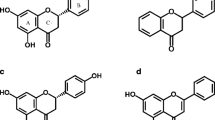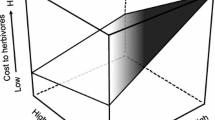Abstract
In a given period of time, herbivores often eat less as dietary plant secondary metabolite (PSM) concentrations increase. This reduction in total food intake is interpreted as a need for the herbivore to regulate PSM ingestion in order to avoid toxication. However, regulation of PSM ingestion involves more than the reduction of total intake; it involves an alteration of meal patterns, through a reduction in the number and/or the size of the meals eaten. Despite this, studies of how herbivores alter their meal patterns when offered varying concentrations of PSMs are rare. We investigated whether koalas adjust the number and/or the size of their meals when offered eucalypt foliage varying naturally in concentrations of formylated phloroglucinol compounds (FPCs), a group of PSMs that have previously been shown to inhibit total food intake. High FPC concentrations caused koalas to eat more slowly, eat shorter meals and eat less per meal, which resulted in a reduced total intake. Because increasing FPC concentrations did not cause koalas to alter the number of meals that they ate, clear individual differences between koalas were observed, where some consistently ate fewer larger meals and others ate many smaller meals. Thus, different feeding strategies may still achieve the same outcome of a regulated intake of PSMs. The changes observed match the meal patterns of other herbivores ingesting PSMs known to stimulate nausea and emetic pathways, supporting the idea that feedback signals from nausea are an important way that koalas avoid toxication when eating eucalypt foliage.


Similar content being viewed by others
References
Aldrich CG, Rhodes MT, Miner JL, Kerley MS, Paterson JA (1993) The effects of endophyte-infected tall fescue consumption and use of a dopamine antagonist on intake, digestibility, body temperature, and blood constituents in sheep. Anim Sci 71:158–163
Blundell JE, Rogers PJ, Hill AJ (1985) Behavioural structure and mechanisms of anorexia: calibration of natural and abnormal inhibition of eating. Brain Res Bull 15:371–376
Cork SJ (1996) Optimal strategies for arboreal herbivorous mammals in contrasting forest types: why koalas and colobines are different. Aust J Ecol 21:10–20
Distel RA, Provenza FD (1991) Experience early in life affects voluntary intake of blackbrush by goats. J Chem Ecol 17:421–450
Ellis WAH, Melzer A, Green B, Newgrain K, Hindell MA, Carrick FN (1995) Seasonal variation in water flux, field metabolic rate and food consumption of free-ranging koalas (Phascolarctos cinereus). Aust J Zool 43:59–68
Freeland WJ, Janzen DH (1974) Strategies in herbivory by mammals: the role of plant secondary compounds. Am Nat 108:269–289
Galey FD, Holstege DM, Johnson BJ, Siemens L (1998) Toxicity and diagnosis of oleander (Nerium oleander) poisoning in livestock. In: Garland T, Barr AC (eds) Toxic plants and other natural toxicants. CAB International, Oxon, pp 215–219
Harrop CJF, Degabriele R (1976) Digestion and nitrogen metabolism in the koala, Phascolarctos cinereus. Aust J Zool 24:201–215
Jakubas WJ, Gullion GW (1990) Coniferyl benzoate in quaking aspen—a ruffed grouse feeding deterrent. J Chem Ecol 16:1077–1087
Krockenberger A (2003) Meeting the energy demands of reproduction in female koalas, Phascolarctos cinereus: evidence for energetic compensation. J Comp Physiol B 173:531–540
Launchbaugh KL, Provenza FD, Burritt EA (1993) How herbivores track variable environments: response to variability of phytotoxins. J Chem Ecol 19:1047–1056
Lawler IR, Foley WJ, Pass GJ, Eschler BM (1998) Administration of a 5HT3 receptor antagonist increases the intake of diets containing Eucalyptus secondary metabolites by marsupials. J Comp Physiol B 168:611–618
Lawler IR, Stapley J, Foley WJ, Eschler BM (1999) Ecological example of conditioned flavor aversion in plant-herbivore interactions: effect of terpenes of Eucalyptus leaves on feeding by common ringtail and brushtail possums. J Chem Ecol 25:401–415
Lawler IR, Foley WJ, Eschler BM (2000) Foliar concentration of a single toxin creates habitat patchiness for a marsupial folivore. Ecology 81:1327–1338
Lievens S, Flo G, Decuypere E, Van Boven M, Cokelaere M (2003) Simmondsin: effects on meal patterns and choice behavior in rats. Physiol Behav 78:669–677
Logan M, Sanson GD (2002) The effect of tooth wear on the feeding behaviour of free-ranging koalas (Phascolarctos cinereus, Goldfuss). J Zool 256:63–69
Logan M, Sanson GD (2003) The effects of lactation on the feeding behaviour and activity patterns of free-ranging female koalas (Phascolarctos cinereus Goldfuss). Aust J Zool 51:415–428
Marsh KJ, Wallis IR, Foley W (2005) Detoxification rates constrain feeding in common brushtail possums (Trichosurus vulpecula). Ecology 86:2946–2954
Marsh KJ, Wallis IR, McLean S, Sorensen JS, Foley WJ (2006) Conflicting demands on detoxification pathways influence how brushtail possums choose their diets. Ecology 87:2103–2112
Martin RW (1981) Age-specific fertility in three populations of koala, Phascolarctos cinereus (Goldfuss), in Victoria. Aust Wildl Res 8:275–283
Moore BD (2004) Chemical determinants of diet and habitat quality in the koala Phascolarctos cinereus Goldfuss. PhD thesis. Australian National University, Canberra
Moore BD, Wallis IR, Palá-Paúl J, Brophy JJ, Willis RH, Foley WJ (2004) Antiherbivore chemistry of Eucalyptus—cues and deterrents for marsupial folivores. J Chem Ecol 30:1743–1769
Moore BD, Foley WJ, Wallis IR, Cowling A, Handasyde KA (2005) Eucalyptus foliar chemistry explains selective feeding by koalas. Biol Lett 1:64–67
Pfister JA, Provenza FD, Manners GD, Gardner DR, Ralphs MH (1997) Tall larkspur ingestion: can cattle regulate intake below toxic levels? J Chem Ecol 23:759–777
Provenza FD (1995) Postingestive feedback as an elementary determinant of food preference and intake in ruminants. J Range Manage 48:2–17
Provenza FD, Burritt EA, Clausen TP, Bryant JP, Reichardt PB, Distel RA (1990) Conditioned flavor aversion: a mechanism for goats to avoid condensed tannins in blackbrush. Am Nat 136:810–828
Provenza FD, Ortegareyes L, Scott CB, Lynch JJ, Burritt EA (1994) Antiemetic drugs attenuate food aversions in sheep. J Anim Sci 72:1989–1994
Provenza FD, Villalba JJ, Dziba LE, Atwood SB, Banner RE (2003) Linking herbivore experience, varied diets, and plant biochemical diversity. Small Rumin Res 49:257–274
Sorensen JS, Heward E, Dearing MD (2005) Plant secondary metabolites alter the feeding patterns of a mammalian herbivore (Neotoma lepida). Oecologia 146:415–422
Stapley J, Foley WJ, Cunningham R, Eschler B (2000) How well can common brushtail possums regulate their intake of Eucalyptus toxins? J Comp Physiol B 170:211–218
Villalba JJ, Provenza FD (2000) Roles of flavor and reward intensities in acquisition and generalization of food preferences: do strong plant signals always deter herbivory? J Chem Ecol 26:1911–1922
Villalba JJ, Provenza FD, Han G-D (2004) Experience influences diet mixing by herbivores: implications for plant biochemical diversity. Oikos 107:100–109
Wallis IR, Watson ML, Foley WJ (2002) Secondary metabolites in Eucalyptus melliodora: field distribution and laboratory feeding choices by a generalist herbivore, the common brushtail possum. Aust J Zool 50:1–13
West DB, Greenwood MRC, Marshall KA, Woods SC (1987) Lithium chloride, cholecystokinin and meal patterns: evidence that cholecystokinin suppresses meal size in rats without causing malaise. Appetite 8:221–227
Wiggins NL, McArthur C, McLean S, Boyle R (2003) Effects of two plant secondary metabolites, cineole and gallic acid, on nightly feeding patterns of the common brushtail possum. J Chem Ecol 29:1447–1464
Wiggins NL, Marsh KJ, Wallis IR, Foley WJ, McArthur C (2006) Sideroxylonal in Eucalyptus foliage influences foraging behaviour of an arboreal folivore. Oecologia 147:272–279
Acknowledgements
Dr. Kath Handasyde, Dr. Ben Moore and Parks Victoria staff assisted with the capture and release of the koalas. Phillip Island Nature Park, and Marg Healy, in particular, kindly allowed us to use their koala pens and eucalypt plantation. Thanks also to Linda Merrin, Owen and Jan Marsh, and Cora Shiroyama, who helped with some of the care of the koalas. Dr. Ann Cowling and Ms. Christine Donnelly from the Statistical Consulting Unit at the Australian National University gave advice on statistical analyses. This research was approved by the Victorian Department of Sustainability and Environment and the Animal Experimentation Ethics Committee of the Australian National University and conforms to the Australian Code of Practice for the Care and Use of Animals for Scientific Purposes.
Author information
Authors and Affiliations
Corresponding author
Additional information
Communicated by Ulrich Sommer.
Rights and permissions
About this article
Cite this article
Marsh, K.J., Wallis, I.R. & Foley, W.J. Behavioural contributions to the regulated intake of plant secondary metabolites in koalas. Oecologia 154, 283–290 (2007). https://doi.org/10.1007/s00442-007-0828-6
Received:
Accepted:
Published:
Issue Date:
DOI: https://doi.org/10.1007/s00442-007-0828-6




